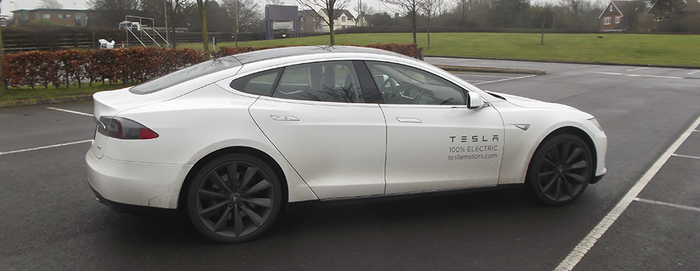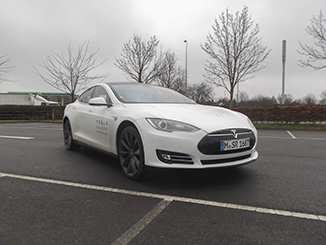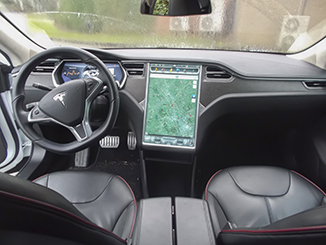Tesla Model S

Tesla Motors are relatively new car manufacturers who only produce electric vehicles. The company was named after electrical engineer and physicist Nikola Tesla. It was founded in 2003 and floated on the NASDAQ stock market in America during 2010. Tesla is now valued at just over $21 billion, based on its current share price of $178. Pretty good when you think it was floated at $17 a share back in 2010!
So even though Tesla had only produced one model - the Tesla Roadster, until the launch of the Model S, the expectations of the company are great. The Tesla Roadster only sold in low numbers; around 2,500 in total. The Model S has already sold 25,000 units worldwide since its start of production in 2012. Tesla has plans to launch the car in many countries and the UK is one of them, hence our first drive of the car.
The car is built at Fremont, San Francisco in an old Toyota factory. Currently just 18% of the floor space is utilised. But as production steps up and more new models are developed the floor space will become operational. Tesla currently produces 650 Model S per week.
The Model S is a full five seat car, but customers can order two rear facing seats that fold away in the boot area. The seats can accommodate small children, making it into a seven-seat car. The car we drove didn’t have this option, therefore I cannot comment on its practicality.

The Model S is around the size of a BMW 5 Series, but has the advantage of a flat rear floor as there is no front to rear drive-train creating a ‘tunnel’. There is certainly enough room in the rear for three adults. The car weighs in at over 2 tons, with around 60% of that coming from the Lithium-Ion batteries. The battery packs have 18,650 cells that are very easily replaced if any of them should fail. The whole of the battery pack can be dropped out of the car and replaced in a matter of minutes. The batteries have thermal management system to keep them at the right temperature for optimum distance, performance and longevity.
The cabin is full of gadgets and goodies and is continually updating the software through internal systems directly linked with the factory. The large 17 inch screen is a bit in your face to start with, but you soon get used to its size. It is so easy to use, all the features are touchscreen and are so intuitive, with hardly a physical button to be seen anywhere. If you can use a smart phone or tablet, then working out all the controls will be second nature. It is that simple, even I could operate them, which is saying something.
Aside from the prominent touch screen, the rest of interior is spoilt by looking a bit inferior. The materials used are not really up to European standards and some parts of it looked a bit old fashioned, especially in contrast the touchscreen controller which is very cutting edge. Tesla did say that future cars would be to a higher standard, but we will have to wait and see.
The Tesla S is made mostly out of aluminium and has roll over bars in its structure for added safety. The body is very rigid and has 50:50 weight distribution. When driving it, you can feel that it is solid, safe and really sticks to the road.

There is a choice of battery packs and motor powers for the Model S. The battery packs are either 60kWh or 85kWh. These are offered with 3 different motor performance outputs, the 60kWh battery can be taken with a 285kW motor that accelerates from 0-60 in 5.9 seconds, has a top speed of 120mph and an estimated range of 242 miles at 55mph. The 85kWh battery has two motor options, a 285kW version that accelerates from 0-60 in 5.4 seconds, has a speed of 125mph and estimated range of 312 miles. The other option is the Performance version which uses a 350kW motor. This sees the 0-60 acceleration time reduce to a very impressive 4.2 seconds, the top speed increases to 130 mph and the range at 55mph stays the same at 312 miles.
Having said all that it’s the torque that is the focal point of the electric car, these three set ups deliver peak torque figures of 440Nm for the 285kW motor option and a whopping 600Nm for the 350kW motor. As with all electric motors the torque is instantaneous, so as soon as you hit the accelerator it’s away with no lag whatsoever.
We drove the car around Oxford on a variety of roads, including some twisty country lanes and on the motorway. The last time I went as quick from 40mph to 70mph was in Concord on Manchester airport runway! The Model S has amazing acceleration, it was so exhilarating, it really did push you back in your seat, words cannot really describe the power that went to the wheels. The car is also very calm when it needs to be and is as happy trundling in town at 5mph as it is travelling at 70mph
The car is very pretty, the styling superb and it looks stunning from every angle. The designers have managed to create a car that is super-quick, zero-emissions, yet doesn’t look quirky or shouts out “look at me, I’m very green” - a handsome beast it certainly is.

The NEDC certified range for the 85kWh battery pack is 300 miles as opposed to the estimated range given by Tesla of 312 miles. In reality, driving it sensibly and keeping up with traffic flows it will achieve around 220 – 240 miles. If you drive it hard it can drop as low as 180 miles. To fill the batteries back up you can ‘Super Charge’ them from a low level to 80% in 20 minutes. Charging the Models S at home from a standard 3 pin socket, you will gain around 25 – 30 miles of range per hour of charging; therefore 8 hours charging will give you over 200 miles range. While the cost of this depends on the time of day and the supplier tariff, Tesla estimates the cost to be around £4.50 per full charge.
The battery pack warranty on the 85kWh is 8 years unlimited mileage and the 60kWh pack is 8 years 125,000 miles. The motor has a 500,000 mile warranty, so they are pretty confident about reliability and quality. Tesla did say that even if the car never has a service, the warranty will not be void and they will still honour any claims. This also applies to any damage inflicted on the batteries by the owner due to attaching the incorrect power supply. If by some chance the batteries get damaged Tesla will replace them under warranty. They are very confident that the on-board software will prevent any damage in the first place.
So where do you buy a Tesla? At the moment it is fairly limited, just one ‘Store’ in a shopping centre on the outskirts of London, although two or three others are planned in other UK cities. Where do you get it serviced? The answer is similar. How long would you have to wait for one? Tesla says around 6 -7months at the moment.
Prices for the Model S 60kWh start from £54,900 OTR. But the one to have, the 85kWh, is priced from £62,300 OTR. Also at the moment with it being a full electric car you can claim the Government incentive of £5,000, which means the lead in model drops to just below £50,000. You can add options such leather, larger wheels and air suspension. You could easily add another £10,000 worth of options and Tesla’s website actually has an option to ‘Max out’ your model S which will add (depending on which model you chose) between £24,000 and £27,000 worth of optional extras.
With great styling, cheap fuelling costs and all that amazing power combined with a very reasonable range that will allow you to get 100 miles from home and back without a battery charge, it starts to add up towards making a good package. When you dial in the price positioning, it really does start to make sense; I never thought I would hear myself saying that!
Martin Ward, Manufacturer Relationship Manager


